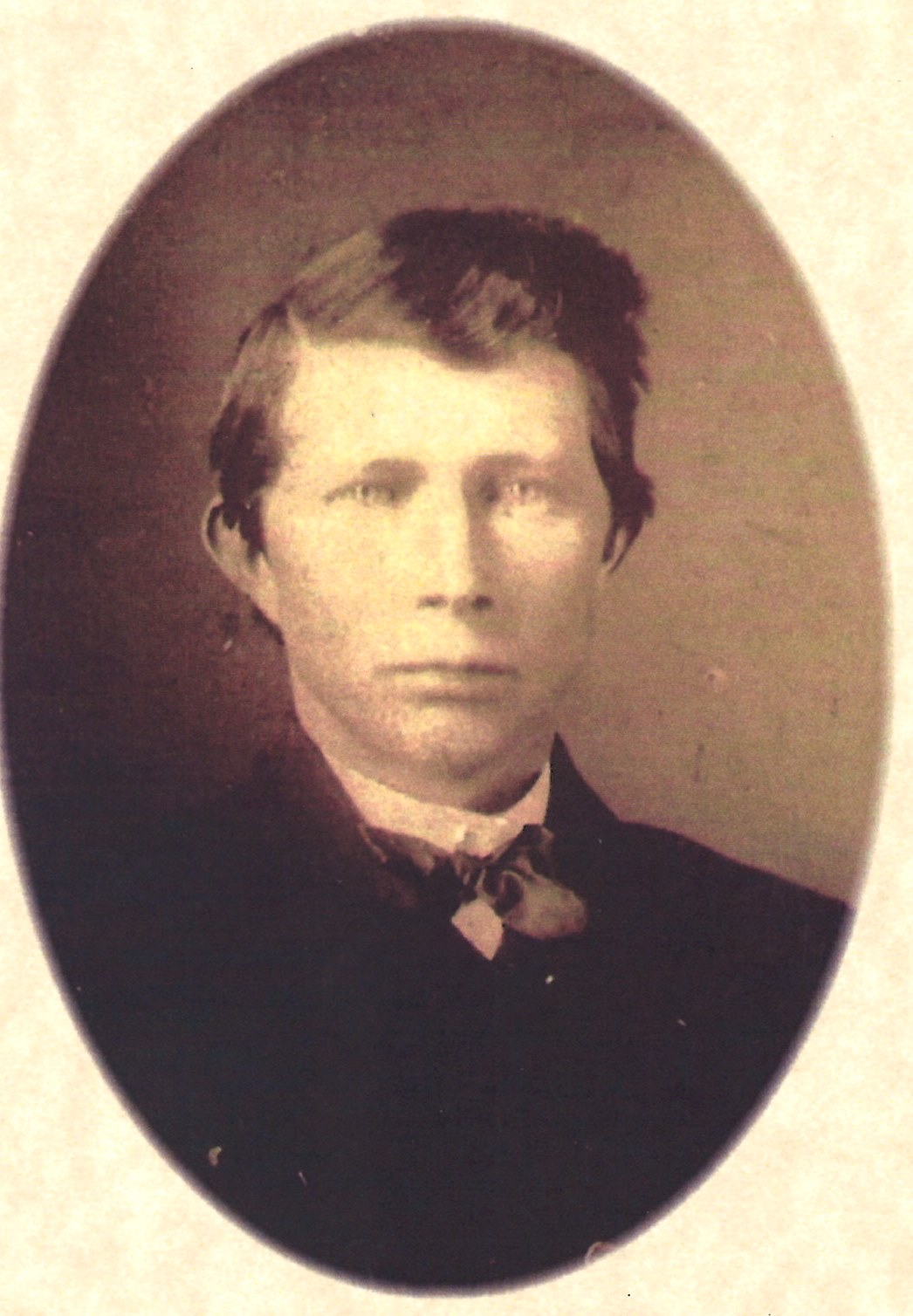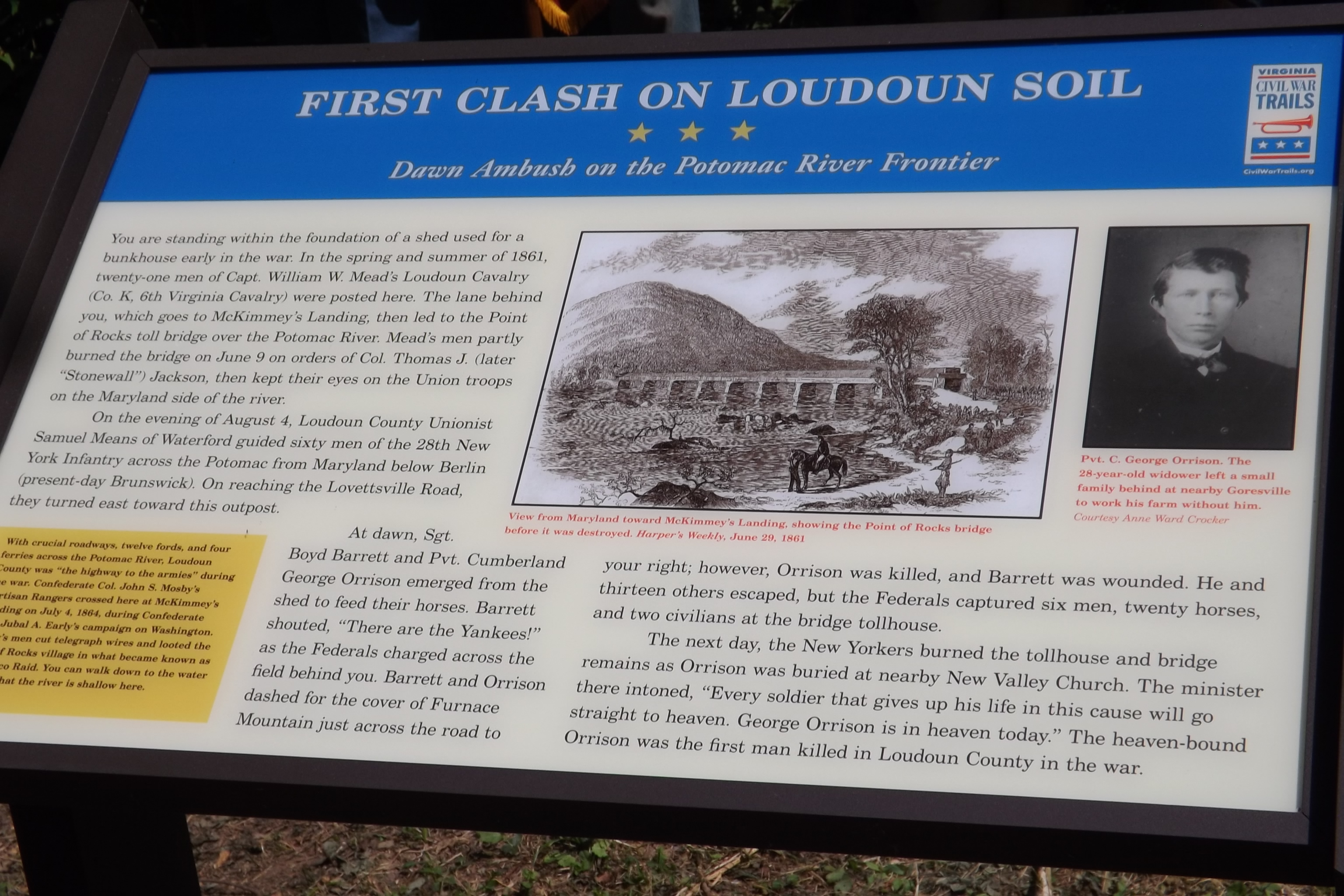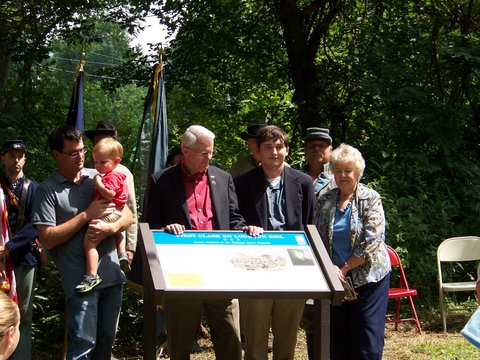“He fell at his post…” The Death and Remembrance of Cumberland George Orrison

Sometimes working in the history field you come across a story that personalizes your view of the past. One of the moments of childhood I can remember clearly was when I read a roster of the 43rd Virginia Battalion of cavalry (Mosby’s Rangers) and found an “Orrison” listed. Since that time, I have found many other family connections to the Civil War. But one would not be so moving or impress me as much as Cumberland George Orrison.
I first read about George Orrison back in high school. In a local paper, they had a section on Loudoun County Civil War history with a top ten fact list. One of the facts was that a man named Cumberland George Orrison was the first soldier killed in Loudoun County during the Civil War. Of course, my last name is pretty unique and I knew my family had been in Loudoun County a long time, so my interest was piqued. But other interests came along and it would take time for me to learn how to do genealogical research.
I was contacted in the early 2000’s from a descendant of Cumberland George Orrison who was doing research on her family at the Thomas Balch genealogy library in Leesburg. Thus began a long road that led to places I never could have imagined.
Cumberland George Orrison was born October 4, 1832 in a place called Furnace Mountain, VA (modern day Rt. 15 crossing of the Potomac River). By 1860, he lived on a farm near Goresville (near modern day Lucketts) and listed in the census as a “farmer.” By 1860, his young wife passed away and his mother and siblings were living with him on the farm. But soon, like many other farms across the country, life was about to change drastically.
Never writing down his own personal reasons for joining the military, Orrison enlisted on April 22, 1861 in the Loudoun Cavalry (soon to be Company K, 6th Virginia Cavalry). He participated with the company at the First Battle of Manassas and by August 1861 the Loudoun Cavalry returned to Loudoun County and worked picket posts at the various Potomac River crossings. Loudoun County was unique because it was on the border between Maryland and western Virginia (soon to be West Virginia). Sentiments on secession were not strong everywhere in the county, with a strong Unionist population in northwest Loudoun. During the time of secession, many pro-southerners were running out Unionist leaders and many fled to Maryland for protection. Many of these leaders then returned to their native county, assisting Federal forces.

On August 4th, one such Unionist leader from Loudoun County, Samuel Means of Waterford, led the 28th New York infantry across the Potomac River at a little known ford near Berlin, MD (now Brunswick). Their objective was to move south and capture any Confederates in the area. This was one of many Federal forays into Loudoun County. Federal forces frequently raided into Loudoun for supplies, capturing Confederates and destroying buildings along the Potomac that could be used for sharpshooters. Means was an out spoken critic of secession and feared for his family’s welfare. He believed Federal forces could protect him and frequently informed them of Confederate whereabouts.
At the same time that Means was leading the New Yorkers into Virginia, the Loudoun Cavalry manned several outposts. One was at Samuel Howser’s tollhouse next to the Point of Rocks Bridge. Howser ran the tollhouse, the ferry, and served as the local postmaster of the area. The Point of Rocks Bridge was recently partially burned by the Loudoun Cavalry by orders of Brig. Gen. Thomas Jackson. Sergeant Boyd Barrett posted vedettes along the roads leading to the tollhouse then he and the rest of the squadron laid down for the night.
North of the bridge the 28th New York marched down the Lovettsville Road, quickly capture the two vedettes posted by Barrett. On morning of August 5th the Federals approached the fields near Howser’s tollhouse complex. Orrison along with Sergeant Barrett had just woken up and were feeding their horses. Some other members of their squadron were eating breakfast inside Howser’s Tollhouse. As Barrett was filling his arms with corn, a yell came out across the field behind him. Several companies of the 28th New York were charging across the field with bayonets drawn. Both Barrett and Orrison were unarmed and both ran to get their side arms.
As the New Yorkers rushed in around the sheds of the tollhouse, Orrison fired back at the Federals. Both Barrett and Orrison ran, firing, towards the tollhouse to take cover. The rest of squadron flew to nearby Furnace Mountain. Barrett was shot three times but hid in some bushes by the road, sadly Cumberland George Orrison was hit in the arm and head. He died in the intersection of the Furnace and Lovettsville roads.
The Federals also captured four Confederates (George’s cousin, Jonah Orrison being one) and Sam Howser the owner of the tollhouse. After securing their prisoners, captured horses and supplies, the New Yorkers returned to Sandy Hook, MD near Harper’s Ferry. The body of George Orrison was found in a blanket laying on the porch of the tollhouse. Later that day his family retrieved his body and he was interred at New Valley Baptist Church the next day. Due to the constant threat of Federal excursions, few members of the Loudoun Cavalry attended the service. The wounded Sergeant Barrett was one of them.
Though the action at Furnace Mountain was small, its impact was large on a community yet untouched by war. Orrison was remembered in songs, sermons and various local newspaper accounts. The attention of the death of one soldier shows the naivety of the population to the war they were about to endure. Orrison, a common farmer and not a trained soldier would be the first of many well-liked neighbors of Loudoun County to fall.
On August 12 the Loudoun Cavalry held an organizational meeting to honor Orrison and draft resolutions to be printed in the local paper, the Leesburg Democratic Mirror. Among the resolutions, they stated “that as a patriot he stepped promptly forward in defense of his country forsaking all for Her good; as a patriot he fell in Her defense; as a soldier he fell at his post.” The most recent tribute to Cumberland George Orrison took place on July 26th, at the location of his death near the modern day Point of Rocks bridge. A decent crowd gathered, with local officials, descendants and history buffs to see a new Civil War Trails marker unveiled telling the story of the Furnace Mountain skirmish. The marker is in the foundation of the shed where Orrison spent the night on August 4th. Featured on the sign is Cumberland George Orrison. I had the pleasure to attend the dedication and made a few remarks. I was there just not as a descendant, but also as a Board member of Civil War Trails.
It reminded me these stories of 150 years ago can still impact us today. There in my

professional duty as a Director of Civil War Trails, speaking at a marker that just happens to be about my ancestor. As I said that day, whether they were north or south, we must remember these men as people like us. To personalize their experience is to understand it and understand our own experiences.
Sometimes, the story of a little known private can be more influential and important than the story of a general. They were fathers, sons, brothers and husbands and had families they left behind. That is our opportunity to connect these stories to the modern public. Cumberland George Orrison reminded me of that and I’m forever grateful for those involved in telling his story.
Thank you for sharing this story Mr. Orrison. Your work is appreciated.
Great story of personal tragedy at the start of the war, and how the smallest of actions/incidents can resonate forward over 150 years.
My father, brother, and grandfather are all named George Orrison. My father and grandfather are deceased. My husband and I attended the anniversary of Cumberland George Orrison’s death a few years ago and found all this very interesting as it was the first I had heard of him. Thank you for putting this in writing.
That is great! Its nice to meet a distant cousin, even virtually! If you have any information on your side of the Orrison family, please let me know. My email is orrison76@hotmail.com